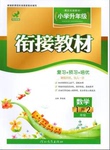题目内容
Trees can be ________ paper while this paper is ________ rice straw.
- A.made of; made from
- B.made from; made of
- C.made out of; made up of
- D.made into; made from
D
【巧解导析】此句意为“树可以制成纸,而这种纸是由稻草做的.”
【巧解导析】此句意为“树可以制成纸,而这种纸是由稻草做的.”

练习册系列答案
 鹰派教辅衔接教材河北教育出版社系列答案
鹰派教辅衔接教材河北教育出版社系列答案
相关题目